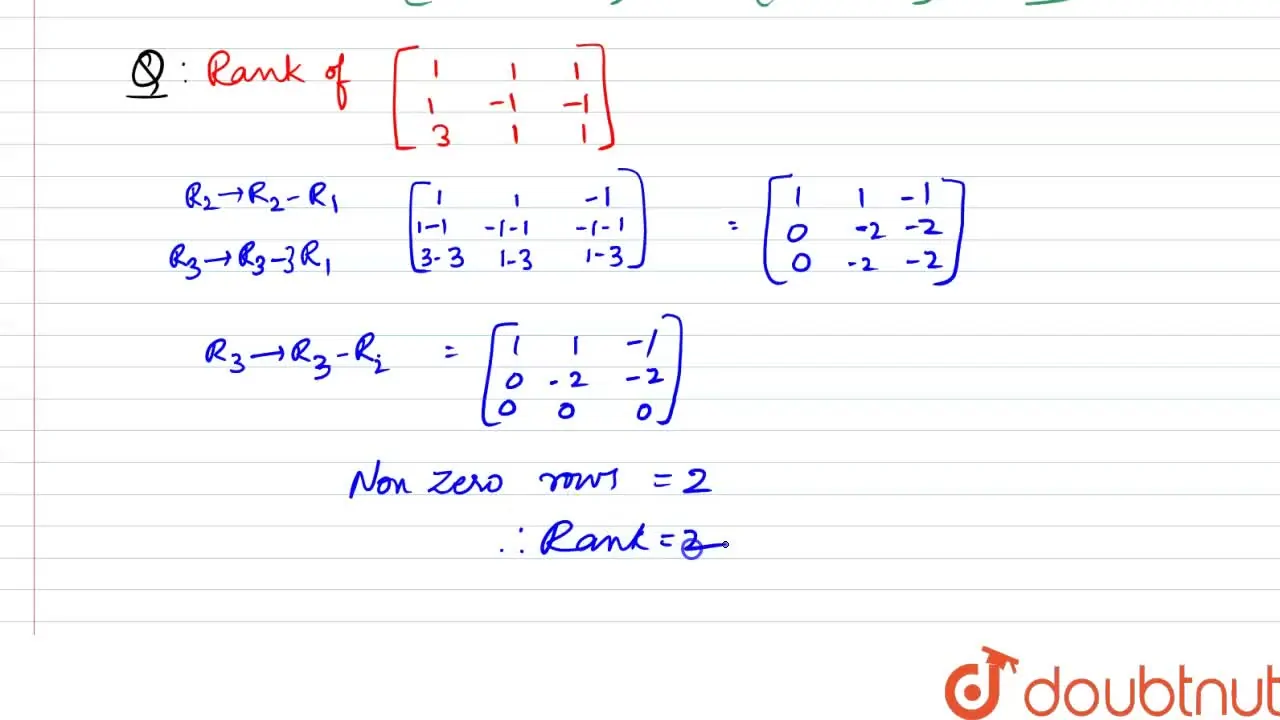Elementary Transformation of a matrix:
The following operation on a matrix are called elementary operations (transformations)
1. The interchange of any two rows (or columns)
2. The multiplication of the elements of any row (or column) by any nonzero number
3. The addition to the elements of any row (or column) the corresponding elements of any other row (or column) multiplied by any number
Echelon Form of matrix : A matrix A is said to be in echelon form if
(i) every row of A which has all its elements 0, occurs below row, which has a non-zero elements
(ii) the first non-zero element in each non –zero row is 1.
(iii) The number of zeros before the first non zero elements in a row is less than the number of such zeros in the next now.
[ A row of a matrix is said to be a zero row if all its elements are zero]
Note: Rank of a matrix does not change by application of any elementary operations
For example ⎡⎢⎣113012000⎤⎥⎦,⎡⎢⎣113601220000⎤⎥⎦ are echelon forms
The number of non-zero rows in the echelon form of a matrix is defined as its RANK. For example we can reduce the matrix A=⎡⎢⎣1232473610⎤⎥⎦ into echelon form using following elementary row transformation.
(i)R2→R2−2R1 and R3→R3−3R1⎡⎢⎣123001001⎤⎥⎦
(ii)R2→R2−2R1⎡⎢⎣123001000⎤⎥⎦
This is the echelon form of matrix A Number of nonzero rows in the echelon form =2 ⇒ Rank of the matrix A is 2
Rank of the matrix ⎡⎢⎣1111−1−1311⎤⎥⎦ is :
1
2
3
0
The correct Answer is:C
Step by step video & image solution for Elementary Transformation of a matrix: The following operation on a matrix are called elementary operations (transformations) 1. The interchange of any two rows (or columns) 2. The multiplication of the elements of any row (or column) by any nonzero number 3. The addition to the elements of any row (or column) the corresponding elements of any other row (or column) multiplied by any number Echelon Form of matrix : A matrix A is said to be in echelon form if (i) every row of A which has all its elements 0, occurs below row, which has a non-zero elements (ii) the first non-zero element in each non –zero row is 1. (iii) The number of zeros before the first non zero elements in a row is less than the number of such zeros in the next now. [ A row of a matrix is said to be a zero row if all its elements are zero] Note: Rank of a matrix does not change by application of any elementary operations For example [(1,1,3),(0,1,2),(0,0,0)],[(1,1,3,6),(0,1,2,2),(0,0,0,0)] are echelon forms The number of non-zero rows in the echelon form of a matrix is defined as its RANK. For example we can reduce the matrix A=[(1,2,3),(2,4,7),(3,6,10)] into echelon form using following elementary row transformation. (i)R_2 to R_2 -2R_1 and R_3 to R_3 -3R_1 [(1,2,3),(0,0,1),(0,0,1)] (ii)R_2 to R_2 -2R_1 [(1,2,3),(0,0,1),(0,0,0)] This is the echelon form of matrix A Number of nonzero rows in the echelon form =2 rArr Rank of the matrix A is 2 Rank of the matrix [(1,1,1),(1,-1,-1),(3,1,1)] is : by Maths experts to help you in doubts & scoring excellent marks in Class 12 exams.
Related Playlists
- BOOK - VMC MODULES ENGLISHCHAPTER - MATRICES AND DETERMINANTS EXERCISE - LEVEL 247videos
MATRICES AND DETERMINANTS
- BOOK - VMC MODULES ENGLISHCHAPTER - MATRICES AND DETERMINANTS EXERCISE - Numerical ValueType for JEE Main15videos
MATRICES AND DETERMINANTS
- BOOK - VMC MODULES ENGLISHCHAPTER - JEE MAIN REVISON TEST-23EXERCISE - MATHEMATICS (SECTION 2)5videos
JEE MAIN REVISON TEST-23
- BOOK - VMC MODULES ENGLISHCHAPTER - MOCK TEST 1EXERCISE - PART III : MATHEMATICS (SECTION-2)10videos
MOCK TEST 1
Similar Questions
Elementary Transformation of a matrix:
The following operation on a matrix are called elementary operations (transformations)
1. The interchange of any two rows (or columns)
2. The multiplication of the elements of any row (or column) by any nonzero number
3. The addition to the elements of any row (or column) the corresponding elements of any other row (or column) multiplied by any number
Echelon Form of matrix : A matrix A is said to be in echelon form if
(i) every row of A which has all its elements 0, occurs below row, which has a non-zero elements
(ii) the first non-zero element in each non –zero row is 1.
(iii) The number of zeros before the first non zero elements in a row is less than the number of such zeros in the next now.
[ A row of a matrix is said to be a zero row if all its elements are zero]
Note: Rank of a matrix does not change by application of any elementary operations
For example ⎡⎢⎣113012000⎤⎥⎦,⎡⎢⎣113601220000⎤⎥⎦ are echelon forms
The number of non-zero rows in the echelon form of a matrix is defined as its RANK. For example we can reduce the matrix A=⎡⎢⎣1232473610⎤⎥⎦ into echelon form using following elementary row transformation.
(i)R2→R2−2R1 and R3→R3−3R1⎡⎢⎣123001001⎤⎥⎦
(ii)R2→R2−2R1⎡⎢⎣123001000⎤⎥⎦
This is the echelon form of matrix A Number of nonzero rows in the echelon form =2 ⇒ Rank of the matrix A is 2
The echelon form of the matrix ⎡⎢⎣1343391291341⎤⎥⎦ is :View SolutionFind the inverse using elementary row transformations: [31027]
View SolutionFind the inverse using elementary row transformations: [−112123311]
View SolutionFind the inverse using elementary row transformations: [112311231]
View SolutionFind the inverse using elementary row transformations: [012123311]
View SolutionFind the inverse of the matrix A=⎛⎜⎝12−2−1300−21⎞⎟⎠ by using elementary row transformations.
View SolutionFind the inverse using elementary row transformations: [12023−11−13]
View SolutionFind the inverse using elementary row transformations: [231241372]
View SolutionFind the inverse using elementary row transformations: [2−144023−27]
View SolutionFind the inverse of Matrix A=⎡⎢⎣13−2−30−5250⎤⎥⎦ by using elementary row transformation.
View Solution


